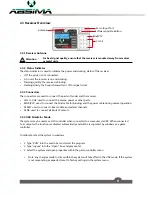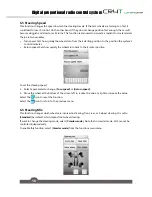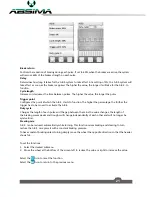
12
Digital proportional radio control system
4. Operation Instructions
After setting up, follow the instructions below to operate the system.
4.1 Power On
Follow the steps below to turn on the system:
1. Check the system and make sure that:
•
The battery is fully charged and installed properly.
•
The receiver is off and correctly installed.
2. Hold the power button until screen lights up.
3. Connect the receiver power supply to the
BIND/VCC
port on the receiver.
The system is now powerd on. Operate with caution, or serious injury could result.
4.2 Binding
The transmitter and receiver have been pre-bound before delivery. If you are using another transmitter or
receiver, follow the steps below to bind the transmitter and receiver:
1. Turn the transmitter on, press
, and swipe from right to left on the screen and then select [
RX
Setup
].
2. Check the currect [
RF std
] and receiver type according to the table below. If you need to change the
standard, select [
RF std
], and [
Yes
] in the confirmation box, and then the desired standard.
3. Select [
Bind with a receiver
] and press [
Yes
] to enter bind mode.
4. Connect the bind cable to the
BIND/VCC
port of the receiver.
5. Connect the power to any other port. The indicator will start to flash, indicating that the receiver is in
bind mode.
•
For [
AFHDS 2A 2-way
], once binding is complete, the transmitter should exit the bind menu
automaticlly.
•
For other protocols, select
to exit the bind menu.
6. Remove the bind and power cable from the receiver. Then connect the power cable to the
BIND/VCC
port.
7. Check the servos' operation. If anything does not work as expected, restart this procedure from the
beginning.
4.3 Pre-use Check
Before operation, perform the following steps to check the system:
1. Check to make sure that all servos and motors are working as expected.
2. Check operating distance: one operator holds the transmitter, and another one moves the model
away from the transmitter. Check the model and mark the distance from where the model starts to
lose control.
Danger
•
Stop operation if any abnormal activity is observed.
Danger
•
Make sure the model does not go out of range.
Attention
•
Sources of interference may affect signal quality.














































